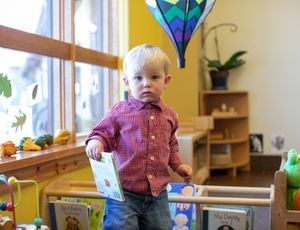Reading to our children has always been referred to as a positive activity. The more we read to children, the better, and not just because it is quality time with our children, but also because of all of the language benefits they get from it. Many studies show how children that are exposed to books from a very young age develop language earlier and have a richer vocabulary than children that do not have this exposure. In this month´s article, we will break down the benefits of reading to them, and will also share some book ideas as well.
Let's start by saying it is never too early to start reading to your child. Some parents ask when it’s a good time to start reading to their child, and the answer is, at the same time you start speaking to them.
Reading to our children means that we will have quality time with them, and that we will share a space and a moment where a book connects us both. It does not matter if it is a short book for a young infant or a more complex book that takes 20 minutes to go through with an older child. Books have always been a part of our lives; we make them a part of our daily time rituals and schedules, and sometimes we might even have a specially designated space to keep all of the books.
Exposing children to oral language is considered something basic that no child should miss in his development, and the reasons we must read to our child are no different:
- It will provide explanations and encourage curiosity.
- It promotes personal connections.
- Older children can read aloud and strengthen their reading, writing, and speaking skills.
- Children will absorb knowledge from books.
- Books help enrich a child’s vocabulary.
- It allows children to hear a well-pronounced vocabulary.
- It provides information about the world around the child.
What should I read to my young child?
The younger the child, the more realistic the books should be. It is ideal to find books with realistic pictures since young children are not ready to understand abstract illustrations. Also, try to use books with simple and realistic stories. Avoid stories that include fantasy, such as talking animals, princesses in distress, dragons, and superheroes since those characters do not exist in real life. We want to offer a realistic image and a connection with the world to our young child. Children enjoy hearing about things that they are familiar with, such as home, family life, daily activities, pets, sibling relationships, etc. Keep in mind that reading to our children does not mean they need to read too, especially the young ones. Books with many words will be a distraction for children under three years since they do not read yet. Aim to use books that have clear, simple images.
As your child gets older, you can start reading books with longer stories and more characters. Use observation as your main tool to decide when to change the type of books you are reading to him. Look to see his interest in the story, as well as how much he is concentrating. If the story is too long and he does not want to finish the book, avoid forcing him. Instead, make a mental note, and the next time you read a book look for a shorter story.
Here are some ideas of the kinds of books to choose:
- Books about family life
- Books with life lessons that teach us something
- Books with language that has a special rhyme or rhythm
- Books that allow children to experience different cultures
- Books that enable children to experience nature
How should I read to my young child?
Many families reserve the moment of reading books exclusively for bedtime since it is part of their routine. However, reading should not be reserved only for bedtime. It is like a language; it should be available during the entire day. Try to have a space to display books for your child. Avoid having too many books at the same time since we do not want to overstimulate her. Instead, pick 5 or 6 books that are available for your child. You can use a basket, book shelf, or a regular, low shelve. Make sure your child can see the cover of the books so she has enough information to choose which one to read.
Before you place a book on display, make sure you have time to read it so you are familiarized with the content of the story. It makes a huge difference when you read a story that you already know.
When you read to your child, she notices not only what you are reading to her, but also the way you hold the book. We want her to see the natural position for reading and turning pages. Sit next to your child, tell the story as you go through the pages, use clear language at a regular pace, and let your child point at images and talk about what she sees. There is no rush to finish the story, so allow her to participate if she wants to. If she wants to turn the page, let her. Cardboard books work better for little toddler fingers; as they grow up, they can manipulate thinner pages independently.
Many toddlers, after multiple times of reading the same story, like to tell the story themselves. Let her tell you the story even if it is not the same as the book. Encourage that creativity and the oral language she shows when she wants to tell you the story.
When you are done reading, place the book carefully back in its place. When you model delicacy and care for the books, children will do the same, and little by little, they will understand that books are essential elements of their environments, and they naturally respect them.
Quote of the Month
“We must never forget that man does not develop only at the university but begins his mental growth at birth, and pursues it with the greatest intensity during the first three years of life.”
-Maria Montessori
Book of the Month
The Reading Aloud Handbook by Jim Trelease
In this book, Jim Trelease talks about the importance of reading to children. He gives many very inspiring examples. He describes clearly the positive impact we can have on children academically and socially if we read to them just a couple of minutes a day. He also includes a great list of books that can be read at loud to people of every age.
Link to buy it at Amazon.com:
https://www.amazon.com/Jim-Treleases-Read-Aloud-Handbook-Eighth/dp/0143133799/ref=sr_1_1?dchild=1&keywords=The+Reading+Aloud+Handbook%C2%A8+by+Jim+Trelease&qid=1594825651&s=books&sr=1-1
Have an extra minute?
Take a minute to analyze this image. Babies learn to speak because they are surrounded by oral language and have a desire to communicate. Likewise, children will become readers and enjoy it if books and reading surround them.



